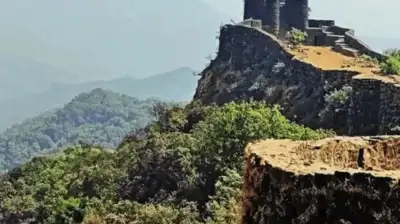ARTICLE AD BOX

Hewn out of cliffs and escarpments in the Sahyadri ranges, perched on islands, and built atop plateaus, Maharashtra’s forts, with their strong Chhatrapati Shivaji links, are now a world treasure.
In a defining moment for India’s cultural heritage, Unesco placed 12 iconic Maratha forts on the global map in July, inscribing them as Maratha Military Landscapes on its list of World Heritage Sites.The Maratha Military Landscapes is a group of 12 forts that were occupied and developed by Maratha rulers between the 17th and 19th centuries: Salher Fort, Shivneri Fort, Lohagad, Khanderi, Raigad Fort, Rajgad Fort, Pratapgad, Suvarnadurg, Panhala Fort, Vijaydurg Fort and Sindhudurg Fort in Maharashtra, and Gingee Fort in Tamil Nadu.

Pride, Tinged With Eviction FearsThe announcement has stirred pride. “For those who have long documented the architectural brilliance and tactical genius of these forts, this is validation long overdue,” says historian Uday Kulkarni.“There is a sense of pride among everyone who follows Maratha history,” says historian Pandurang Balkawade, who is also a member of the state-level fort conservation committee. “Historians, tourists, and students will know about these forts, their history, and role in the Shivajiled Maratha empire.”
Maharashtra’s culture minister Ashish Shelar called the UN designation a proud achievement, reflecting years of meticulous research and community engagement. “The nomination dossier submitted to Unesco provides historical, architectural and cultural justification for why these forts are among the finest in the world, adapted to harsh terrains, reflective of decentralised power structures, strategically positioned to defy larger armies,” he says.Each fort has its own battle legends, apart from details of governance, innovation, cultural assertion and honour. Rajgad, Shivaji’s first capital, was chosen for its natural defences and advantage in overlooking the valleys below. Its triplelayered fortifications, water systems and living quarters showcase how geography was turned into strategy. Salher in Nashik, Maharashtra’s northernmost fort in the list, is the highest in the Sahyadris and the site of a legendary battle in 1672, where the Marathas defeated the Mughals in open combat.Coastal strongholds such as Sindhudurg and Suvarnadurg were constructed not just to repel European naval powers, but also to establish Maratha naval dominance, a rare feat in Indian military history. Shivneri, the birthplace of Shivaji, evokes deep emotion, even though its fortification walls are slowly yielding to time and neglect.Udayanraje Bhosale, the 13th descendant of Shivaji and a BJP MP from Satara, says the forts — which were used by the Marathas in military operations and guerrilla warfare — will now serve not just as tourist destinations but as platforms for learning and identity.“This recognition will have a larger impact on the international understanding of Maratha history,” Bhosale adds. “These sites are valuable resources for studying military architecture, historical warfare, and the cultural traditions of the Maratha Empire. They will also serve as platforms for educational programmes and research initiatives.”Panhala in Kolhapur, a giant among forts, offers sweeping views and holds within its bastions the tale of Chhatrapati Tarabai’s resistance against the Mughals long after her illustrious father-in-law.
It was also where Shivaji famously escaped Siddi Johar’s siege under the cover of night. But today, those living in the fort face a new kind of fear — not of invading armies, but of eviction.Since the day the nomination was proposed, residents of Panhala have been apprehensive. “We’ve been told our rights won’t be affected, but what happens when the collector is transferred? We want it in writing,” says Sachin Kashid, who lives in the fort.
Anand Patil, another resident, says the very people who have protected the fort for generations now fear displacement. “The administration should acknowledge that the fort still stands because of us,” he adds.Recognition: Are We Ready For It?While the Unesco tag promises economic windfall, it also brings the gaze of the world and, with it, responsibility. “Every year, some 8 lakh to 10 lakh tourists visit Panhala Fort. This number will likely double,” archaeology researcher Sachin Patil says.
“If tourism is not controlled, the fort won’t survive. We must discipline tourism, introduce battery-operated transport, regulate food stalls, and shift parking to the foothills.
”The state’s management plan, submitted to Unesco, acknowledges the delicate condition of many forts. Shivneri, for instance, suffers from structural degradation and insufficient sanitation infrastructure; Lohagad and Rajgad lack basic visitor amenities; Suvarnadurg and Sindhudurg battle coastal erosion and salt-laden winds that accelerate decay.“From poorly maintained pathways and lack of clean water to insufficient interpretation signage and no cap on tourist numbers, the problems are many,” says Kranti Divekar, an expert in fort architecture. “Encroachments continue unchecked in some forts, while others are dotted with unregulated hotels and amusement gardens.”Plan To Conserve, But Challenges LoomState archaeology department officials say some forts fall under their jurisdiction, while others are managed by Archaeological Survey of India (ASI).
“We need a comprehensive plan where roles are defined,” says an official from the state department. Manager Singh, a former ASI conservation head, feels Maharashtra should look to Rajasthan. “By allowing private agencies to operate within forts, Rajasthan has not only preserved them but also turned them into economic engines.
Maharashtra must create a revenue framework, where tourism supports preservation,” he says.But there’s also optimism. In the shadow of Rajgad and Torna forts, villagers Gulab Rasal and Gopal Indulkar are already planning. “Locals can run homestays, guide services, and food stalls. We’ve protected these forts for centuries. Let us also benefit from their future,” says Gulab. Umesh Zirpe, head of Akhil Maharashtra Giryarohan Sangh, says the trekking community is excited at the Unesco honour. “This tag will encourage young people to engage with our history.
Trekking is no longer just an adventure, it is an act of cultural connection,” he says.But even as the world applauds, Unesco’s eyes are on India. Forts under World Heritage recognition must meet global standards in conservation, security, access, and community integration. Periodic reviews will determine whether they retain their designation.



.png)
.png)
.png)
















 1 hour ago
6
1 hour ago
6









 English (US) ·
English (US) ·